Primary Health Care: A Comprehensive Analysis of Global Health Systems
VerifiedAdded on 2020/12/31
|10
|3162
|482
Report
AI Summary
This report provides a comprehensive overview of Primary Health Care (PHC), emphasizing its crucial role in strengthening health systems and achieving global health goals, including the Sustainable Development Goals (SDGs). It delves into the principles of PHC, the significance of the Alma Ata Declaration, and the evolution of attitudes towards PHC over time. The report analyzes the importance of updating and reassessing the relevance of PHC in the face of changing global health challenges. The report highlights the case study of a primary healthcare facility and its operations. It also discusses the place of primary health care in health systems strengthening and the challenges faced. The report also explores the ways of appropriately updating and reassessing the relevance of PHC. The report concludes with a discussion on the current emphasis on SDGs and the need for continued investment in PHC to ensure universal health coverage and improve the health and well-being of individuals and communities worldwide. This report is designed to help students understand the importance of PHC in the context of global health.
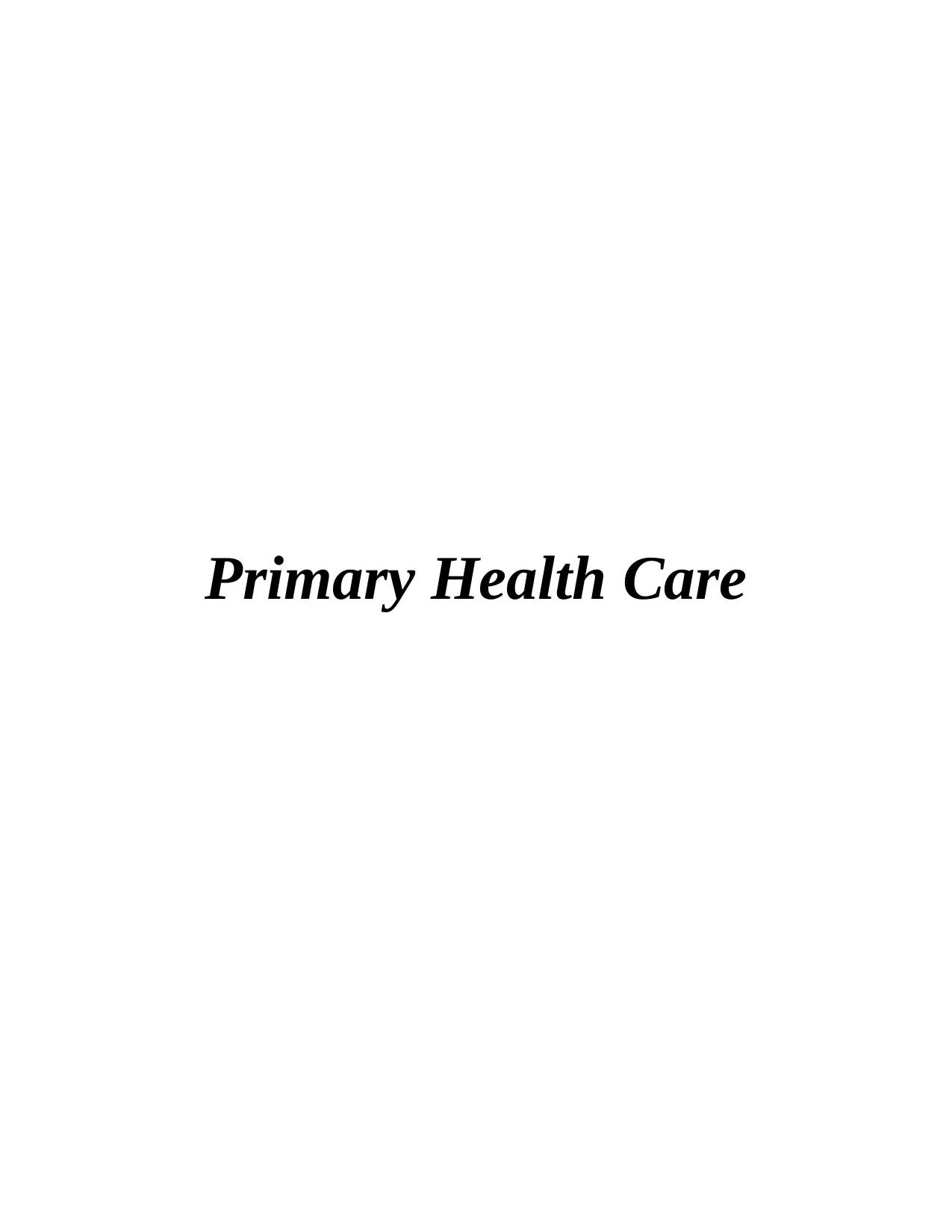
Primary Health Care
Paraphrase This Document
Need a fresh take? Get an instant paraphrase of this document with our AI Paraphraser
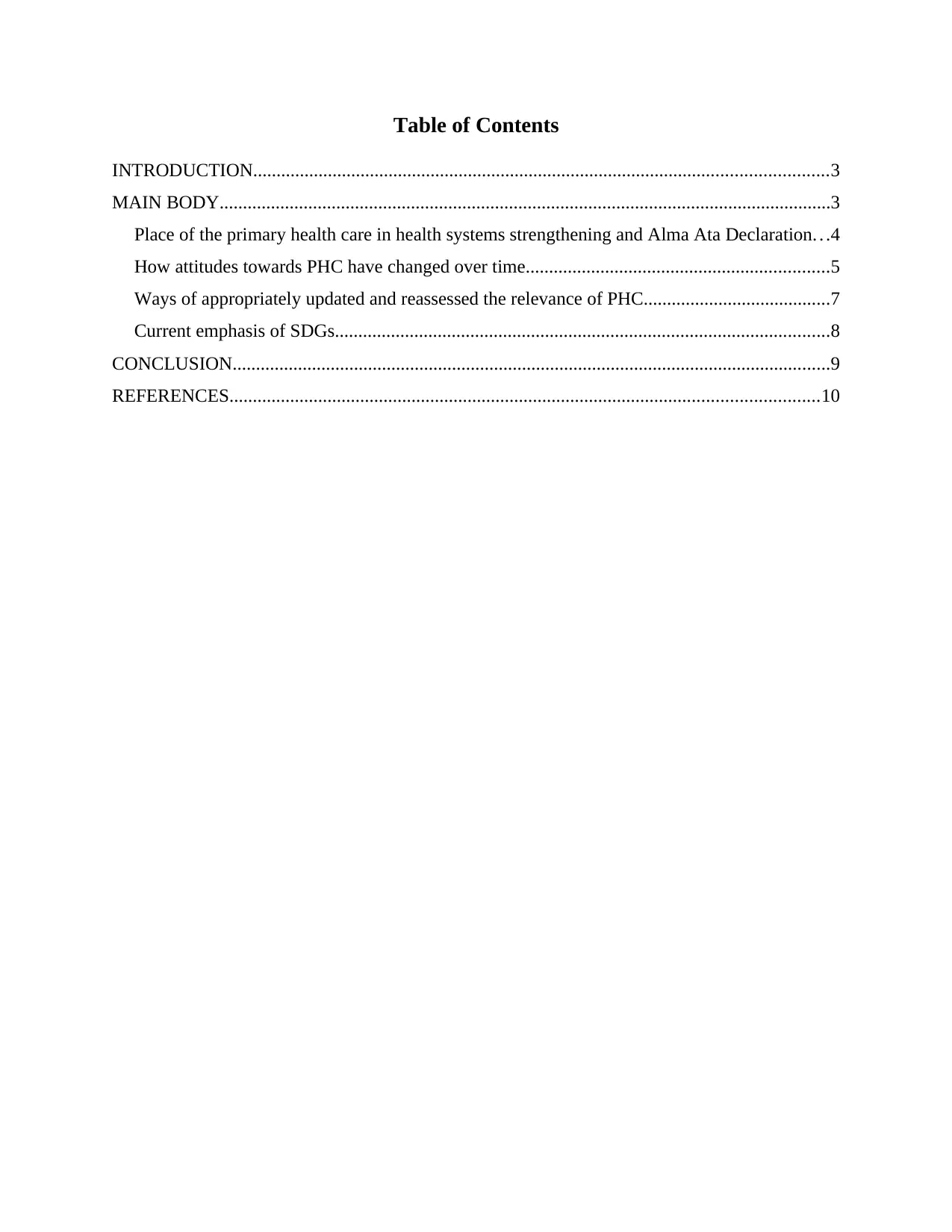
Table of Contents
INTRODUCTION...........................................................................................................................3
MAIN BODY...................................................................................................................................3
Place of the primary health care in health systems strengthening and Alma Ata Declaration. . .4
How attitudes towards PHC have changed over time.................................................................5
Ways of appropriately updated and reassessed the relevance of PHC........................................7
Current emphasis of SDGs..........................................................................................................8
CONCLUSION................................................................................................................................9
REFERENCES..............................................................................................................................10
INTRODUCTION...........................................................................................................................3
MAIN BODY...................................................................................................................................3
Place of the primary health care in health systems strengthening and Alma Ata Declaration. . .4
How attitudes towards PHC have changed over time.................................................................5
Ways of appropriately updated and reassessed the relevance of PHC........................................7
Current emphasis of SDGs..........................................................................................................8
CONCLUSION................................................................................................................................9
REFERENCES..............................................................................................................................10

INTRODUCTION
Primary healthcare refers to the whole society formulation to health and well being
focused on characteristics and needs of individuals, community and families. It mainly focuses
on interrelated and comprehensive aspect of mental, social and physical health as well as well-
being of individual. It also provides person care for the health requirements throughout lifespan,
not only for set of the specific diseases (Baum, 2016). Primary healthcare is non moving in
commitment to the equality and social justice and also recognition of fundamental right to
highest possible standards of health. This assignment will include case study about the primary
healthcare and its strengths. PHC promotes wellness and health seeks to prevent illness and
injuries. It's all about creating conditions which helps individuals to stay and become healthy and
well.
MAIN BODY
Primary health care is very essential in every country. Countries around world agreed to
Declaration of Astana, assuring to the strength primary health care systems are very important
steps to achieve universal health coverage. Meeting maximum people's needs of health through
protective, curative, preventive, rehabilitative and comprehensive promotive care thought the
world. Primary health care is essential to achieve health related Sustainable Development Goals
and the universal health coverage also. This will contributes attainment of various goals beyond
health goal that include poverty, education, clean water, gender equality, work, economic growth
and reducing inequality (Read and et. al., 2017).
Primary health care is very well positioned to respond to the rapid economic,
demographic and technological changes, all of that impact well being and health. Primary health
care has proven to be highly efficient and effective way to address main risk and causes of poor
health. It also includes key elements which are required to improve health security as also
prevent the health threats like antimicrobial and epidemics resistance, through these measures as
education, community engagement and rational prescribing essential public health functions as
well as surveillance. This health care ensures individuals receive comprehensive care which
ranges from prevention and promotion of treatment, palliative care and rehabilitation as near as
feasible to individual's everyday environment. This also about extending reach of health care
providers into the community. PHC is integral part of the country' health system, which is first
level of the contact for people and their families and enables healthcare to provide close to the
Primary healthcare refers to the whole society formulation to health and well being
focused on characteristics and needs of individuals, community and families. It mainly focuses
on interrelated and comprehensive aspect of mental, social and physical health as well as well-
being of individual. It also provides person care for the health requirements throughout lifespan,
not only for set of the specific diseases (Baum, 2016). Primary healthcare is non moving in
commitment to the equality and social justice and also recognition of fundamental right to
highest possible standards of health. This assignment will include case study about the primary
healthcare and its strengths. PHC promotes wellness and health seeks to prevent illness and
injuries. It's all about creating conditions which helps individuals to stay and become healthy and
well.
MAIN BODY
Primary health care is very essential in every country. Countries around world agreed to
Declaration of Astana, assuring to the strength primary health care systems are very important
steps to achieve universal health coverage. Meeting maximum people's needs of health through
protective, curative, preventive, rehabilitative and comprehensive promotive care thought the
world. Primary health care is essential to achieve health related Sustainable Development Goals
and the universal health coverage also. This will contributes attainment of various goals beyond
health goal that include poverty, education, clean water, gender equality, work, economic growth
and reducing inequality (Read and et. al., 2017).
Primary health care is very well positioned to respond to the rapid economic,
demographic and technological changes, all of that impact well being and health. Primary health
care has proven to be highly efficient and effective way to address main risk and causes of poor
health. It also includes key elements which are required to improve health security as also
prevent the health threats like antimicrobial and epidemics resistance, through these measures as
education, community engagement and rational prescribing essential public health functions as
well as surveillance. This health care ensures individuals receive comprehensive care which
ranges from prevention and promotion of treatment, palliative care and rehabilitation as near as
feasible to individual's everyday environment. This also about extending reach of health care
providers into the community. PHC is integral part of the country' health system, which is first
level of the contact for people and their families and enables healthcare to provide close to the
⊘ This is a preview!⊘
Do you want full access?
Subscribe today to unlock all pages.

Trusted by 1+ million students worldwide
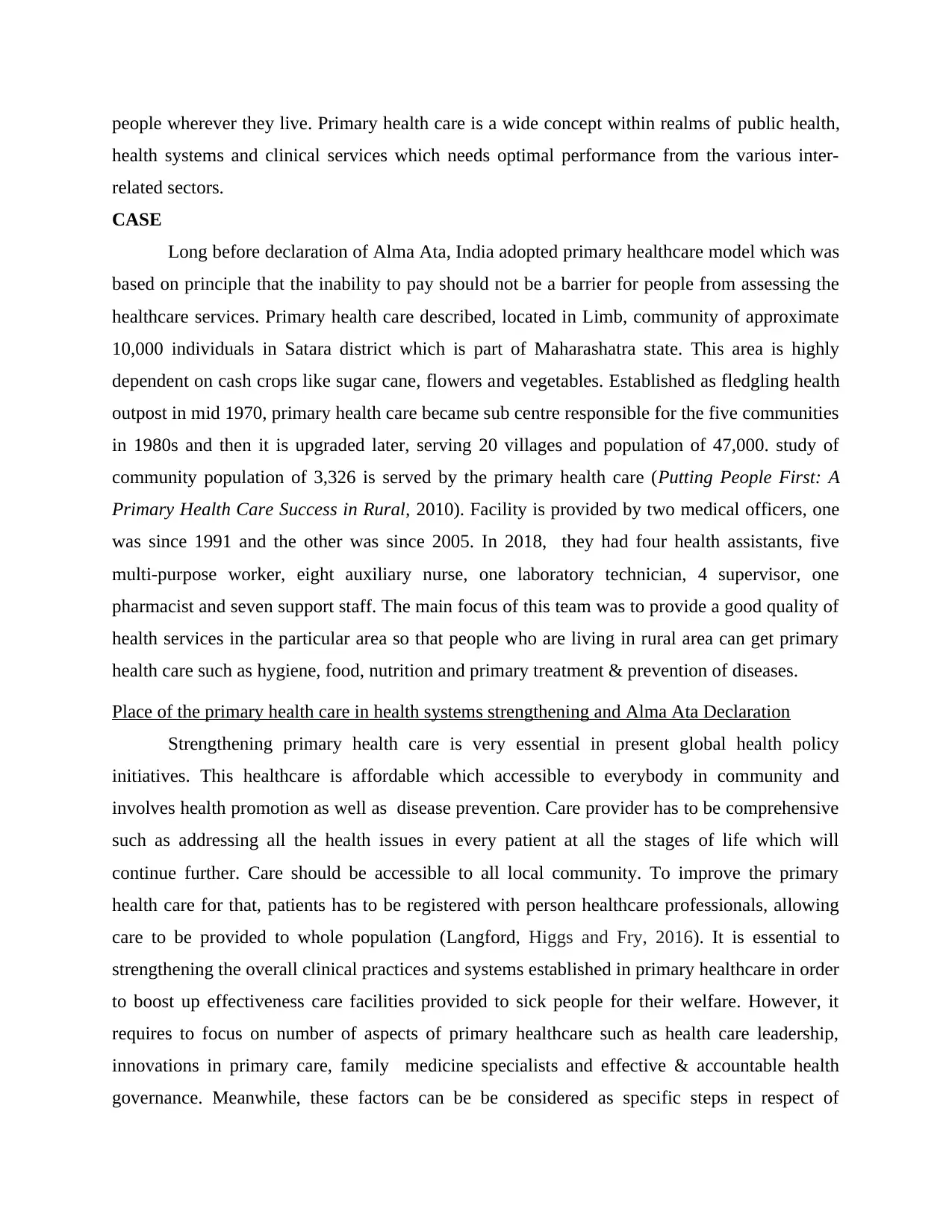
people wherever they live. Primary health care is a wide concept within realms of public health,
health systems and clinical services which needs optimal performance from the various inter-
related sectors.
CASE
Long before declaration of Alma Ata, India adopted primary healthcare model which was
based on principle that the inability to pay should not be a barrier for people from assessing the
healthcare services. Primary health care described, located in Limb, community of approximate
10,000 individuals in Satara district which is part of Maharashatra state. This area is highly
dependent on cash crops like sugar cane, flowers and vegetables. Established as fledgling health
outpost in mid 1970, primary health care became sub centre responsible for the five communities
in 1980s and then it is upgraded later, serving 20 villages and population of 47,000. study of
community population of 3,326 is served by the primary health care (Putting People First: A
Primary Health Care Success in Rural, 2010). Facility is provided by two medical officers, one
was since 1991 and the other was since 2005. In 2018, they had four health assistants, five
multi-purpose worker, eight auxiliary nurse, one laboratory technician, 4 supervisor, one
pharmacist and seven support staff. The main focus of this team was to provide a good quality of
health services in the particular area so that people who are living in rural area can get primary
health care such as hygiene, food, nutrition and primary treatment & prevention of diseases.
Place of the primary health care in health systems strengthening and Alma Ata Declaration
Strengthening primary health care is very essential in present global health policy
initiatives. This healthcare is affordable which accessible to everybody in community and
involves health promotion as well as disease prevention. Care provider has to be comprehensive
such as addressing all the health issues in every patient at all the stages of life which will
continue further. Care should be accessible to all local community. To improve the primary
health care for that, patients has to be registered with person healthcare professionals, allowing
care to be provided to whole population (Langford, Higgs and Fry, 2016). It is essential to
strengthening the overall clinical practices and systems established in primary healthcare in order
to boost up effectiveness care facilities provided to sick people for their welfare. However, it
requires to focus on number of aspects of primary healthcare such as health care leadership,
innovations in primary care, family medicine specialists and effective & accountable health
governance. Meanwhile, these factors can be be considered as specific steps in respect of
health systems and clinical services which needs optimal performance from the various inter-
related sectors.
CASE
Long before declaration of Alma Ata, India adopted primary healthcare model which was
based on principle that the inability to pay should not be a barrier for people from assessing the
healthcare services. Primary health care described, located in Limb, community of approximate
10,000 individuals in Satara district which is part of Maharashatra state. This area is highly
dependent on cash crops like sugar cane, flowers and vegetables. Established as fledgling health
outpost in mid 1970, primary health care became sub centre responsible for the five communities
in 1980s and then it is upgraded later, serving 20 villages and population of 47,000. study of
community population of 3,326 is served by the primary health care (Putting People First: A
Primary Health Care Success in Rural, 2010). Facility is provided by two medical officers, one
was since 1991 and the other was since 2005. In 2018, they had four health assistants, five
multi-purpose worker, eight auxiliary nurse, one laboratory technician, 4 supervisor, one
pharmacist and seven support staff. The main focus of this team was to provide a good quality of
health services in the particular area so that people who are living in rural area can get primary
health care such as hygiene, food, nutrition and primary treatment & prevention of diseases.
Place of the primary health care in health systems strengthening and Alma Ata Declaration
Strengthening primary health care is very essential in present global health policy
initiatives. This healthcare is affordable which accessible to everybody in community and
involves health promotion as well as disease prevention. Care provider has to be comprehensive
such as addressing all the health issues in every patient at all the stages of life which will
continue further. Care should be accessible to all local community. To improve the primary
health care for that, patients has to be registered with person healthcare professionals, allowing
care to be provided to whole population (Langford, Higgs and Fry, 2016). It is essential to
strengthening the overall clinical practices and systems established in primary healthcare in order
to boost up effectiveness care facilities provided to sick people for their welfare. However, it
requires to focus on number of aspects of primary healthcare such as health care leadership,
innovations in primary care, family medicine specialists and effective & accountable health
governance. Meanwhile, these factors can be be considered as specific steps in respect of
Paraphrase This Document
Need a fresh take? Get an instant paraphrase of this document with our AI Paraphraser
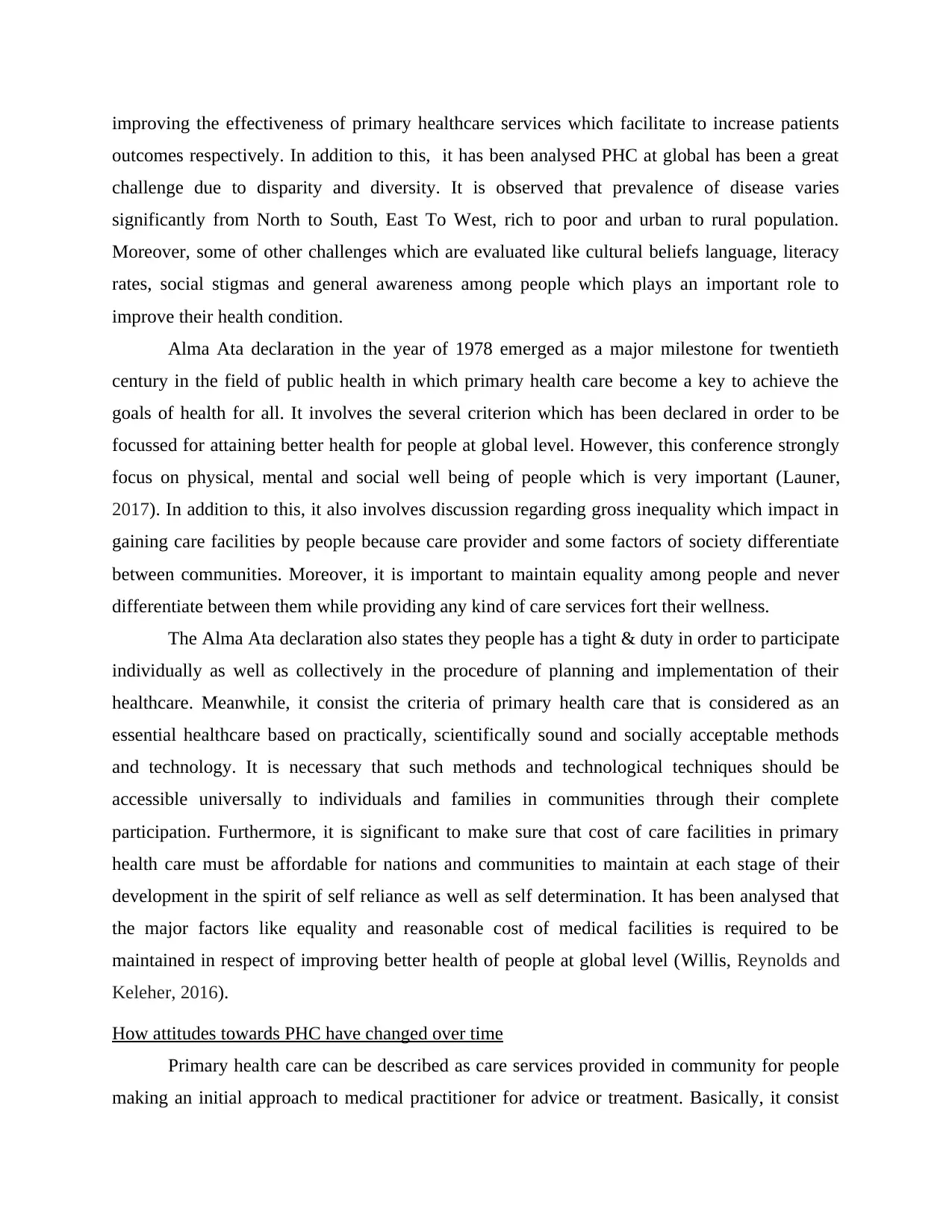
improving the effectiveness of primary healthcare services which facilitate to increase patients
outcomes respectively. In addition to this, it has been analysed PHC at global has been a great
challenge due to disparity and diversity. It is observed that prevalence of disease varies
significantly from North to South, East To West, rich to poor and urban to rural population.
Moreover, some of other challenges which are evaluated like cultural beliefs language, literacy
rates, social stigmas and general awareness among people which plays an important role to
improve their health condition.
Alma Ata declaration in the year of 1978 emerged as a major milestone for twentieth
century in the field of public health in which primary health care become a key to achieve the
goals of health for all. It involves the several criterion which has been declared in order to be
focussed for attaining better health for people at global level. However, this conference strongly
focus on physical, mental and social well being of people which is very important (Launer,
2017). In addition to this, it also involves discussion regarding gross inequality which impact in
gaining care facilities by people because care provider and some factors of society differentiate
between communities. Moreover, it is important to maintain equality among people and never
differentiate between them while providing any kind of care services fort their wellness.
The Alma Ata declaration also states they people has a tight & duty in order to participate
individually as well as collectively in the procedure of planning and implementation of their
healthcare. Meanwhile, it consist the criteria of primary health care that is considered as an
essential healthcare based on practically, scientifically sound and socially acceptable methods
and technology. It is necessary that such methods and technological techniques should be
accessible universally to individuals and families in communities through their complete
participation. Furthermore, it is significant to make sure that cost of care facilities in primary
health care must be affordable for nations and communities to maintain at each stage of their
development in the spirit of self reliance as well as self determination. It has been analysed that
the major factors like equality and reasonable cost of medical facilities is required to be
maintained in respect of improving better health of people at global level (Willis, Reynolds and
Keleher, 2016).
How attitudes towards PHC have changed over time
Primary health care can be described as care services provided in community for people
making an initial approach to medical practitioner for advice or treatment. Basically, it consist
outcomes respectively. In addition to this, it has been analysed PHC at global has been a great
challenge due to disparity and diversity. It is observed that prevalence of disease varies
significantly from North to South, East To West, rich to poor and urban to rural population.
Moreover, some of other challenges which are evaluated like cultural beliefs language, literacy
rates, social stigmas and general awareness among people which plays an important role to
improve their health condition.
Alma Ata declaration in the year of 1978 emerged as a major milestone for twentieth
century in the field of public health in which primary health care become a key to achieve the
goals of health for all. It involves the several criterion which has been declared in order to be
focussed for attaining better health for people at global level. However, this conference strongly
focus on physical, mental and social well being of people which is very important (Launer,
2017). In addition to this, it also involves discussion regarding gross inequality which impact in
gaining care facilities by people because care provider and some factors of society differentiate
between communities. Moreover, it is important to maintain equality among people and never
differentiate between them while providing any kind of care services fort their wellness.
The Alma Ata declaration also states they people has a tight & duty in order to participate
individually as well as collectively in the procedure of planning and implementation of their
healthcare. Meanwhile, it consist the criteria of primary health care that is considered as an
essential healthcare based on practically, scientifically sound and socially acceptable methods
and technology. It is necessary that such methods and technological techniques should be
accessible universally to individuals and families in communities through their complete
participation. Furthermore, it is significant to make sure that cost of care facilities in primary
health care must be affordable for nations and communities to maintain at each stage of their
development in the spirit of self reliance as well as self determination. It has been analysed that
the major factors like equality and reasonable cost of medical facilities is required to be
maintained in respect of improving better health of people at global level (Willis, Reynolds and
Keleher, 2016).
How attitudes towards PHC have changed over time
Primary health care can be described as care services provided in community for people
making an initial approach to medical practitioner for advice or treatment. Basically, it consist
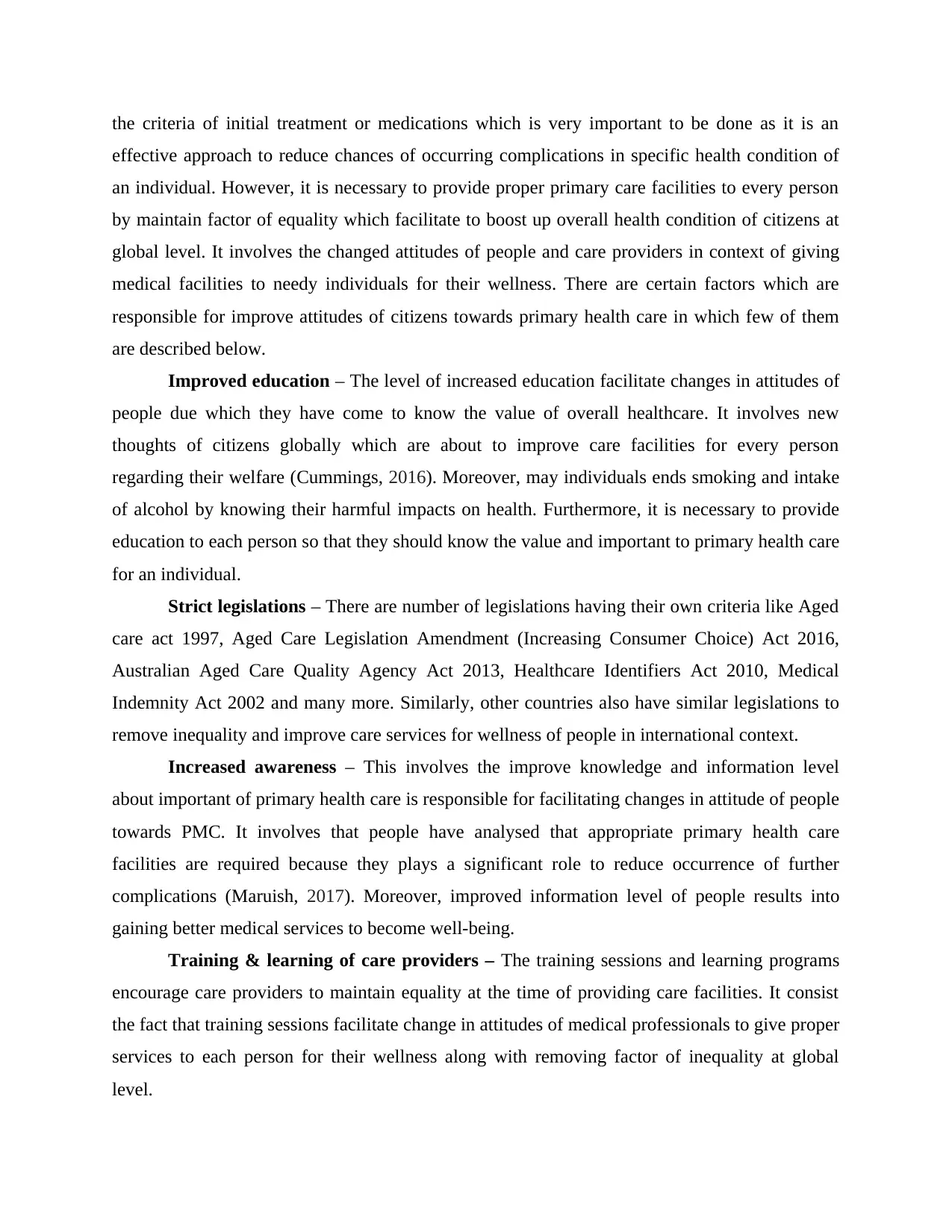
the criteria of initial treatment or medications which is very important to be done as it is an
effective approach to reduce chances of occurring complications in specific health condition of
an individual. However, it is necessary to provide proper primary care facilities to every person
by maintain factor of equality which facilitate to boost up overall health condition of citizens at
global level. It involves the changed attitudes of people and care providers in context of giving
medical facilities to needy individuals for their wellness. There are certain factors which are
responsible for improve attitudes of citizens towards primary health care in which few of them
are described below.
Improved education – The level of increased education facilitate changes in attitudes of
people due which they have come to know the value of overall healthcare. It involves new
thoughts of citizens globally which are about to improve care facilities for every person
regarding their welfare (Cummings, 2016). Moreover, may individuals ends smoking and intake
of alcohol by knowing their harmful impacts on health. Furthermore, it is necessary to provide
education to each person so that they should know the value and important to primary health care
for an individual.
Strict legislations – There are number of legislations having their own criteria like Aged
care act 1997, Aged Care Legislation Amendment (Increasing Consumer Choice) Act 2016,
Australian Aged Care Quality Agency Act 2013, Healthcare Identifiers Act 2010, Medical
Indemnity Act 2002 and many more. Similarly, other countries also have similar legislations to
remove inequality and improve care services for wellness of people in international context.
Increased awareness – This involves the improve knowledge and information level
about important of primary health care is responsible for facilitating changes in attitude of people
towards PMC. It involves that people have analysed that appropriate primary health care
facilities are required because they plays a significant role to reduce occurrence of further
complications (Maruish, 2017). Moreover, improved information level of people results into
gaining better medical services to become well-being.
Training & learning of care providers – The training sessions and learning programs
encourage care providers to maintain equality at the time of providing care facilities. It consist
the fact that training sessions facilitate change in attitudes of medical professionals to give proper
services to each person for their wellness along with removing factor of inequality at global
level.
effective approach to reduce chances of occurring complications in specific health condition of
an individual. However, it is necessary to provide proper primary care facilities to every person
by maintain factor of equality which facilitate to boost up overall health condition of citizens at
global level. It involves the changed attitudes of people and care providers in context of giving
medical facilities to needy individuals for their wellness. There are certain factors which are
responsible for improve attitudes of citizens towards primary health care in which few of them
are described below.
Improved education – The level of increased education facilitate changes in attitudes of
people due which they have come to know the value of overall healthcare. It involves new
thoughts of citizens globally which are about to improve care facilities for every person
regarding their welfare (Cummings, 2016). Moreover, may individuals ends smoking and intake
of alcohol by knowing their harmful impacts on health. Furthermore, it is necessary to provide
education to each person so that they should know the value and important to primary health care
for an individual.
Strict legislations – There are number of legislations having their own criteria like Aged
care act 1997, Aged Care Legislation Amendment (Increasing Consumer Choice) Act 2016,
Australian Aged Care Quality Agency Act 2013, Healthcare Identifiers Act 2010, Medical
Indemnity Act 2002 and many more. Similarly, other countries also have similar legislations to
remove inequality and improve care services for wellness of people in international context.
Increased awareness – This involves the improve knowledge and information level
about important of primary health care is responsible for facilitating changes in attitude of people
towards PMC. It involves that people have analysed that appropriate primary health care
facilities are required because they plays a significant role to reduce occurrence of further
complications (Maruish, 2017). Moreover, improved information level of people results into
gaining better medical services to become well-being.
Training & learning of care providers – The training sessions and learning programs
encourage care providers to maintain equality at the time of providing care facilities. It consist
the fact that training sessions facilitate change in attitudes of medical professionals to give proper
services to each person for their wellness along with removing factor of inequality at global
level.
⊘ This is a preview!⊘
Do you want full access?
Subscribe today to unlock all pages.

Trusted by 1+ million students worldwide

Ways of appropriately updated and reassessed the relevance of PHC
The updation of primary health care is essential in order to increase effectiveness of
clinical practices and procedures which helps to boost up patient outcomes. It is necessary for
care provides authorities or agencies, government and social carers to focus on aspects in which
PMC can be upgrade itself at global level. Meanwhile, it is essential to utilise advance
technology and other innovations in clinical practices which facilitate to maintain proper records
and conduct immediate actions for wellness of particular patient. In addition to this, up gradation
id beneficial for improving overall health level of citizens in context of international population
(Thomas, 2017). Moreover, here are number of aspects that are required to be focussed regarding
updation of PMC in which some of them are given below.
Utilise advanced technological system – The technological advancement is very
important in primary health care as it facilitate to provide better services in order to make an
individual well-being as soon s possible. It consist the criteria fort care practitioners to use
innovative technological aids and devices for providing appropriate medical facility in lees
duration of time. Moreover, PMC requires updation in terms of advanced technology at global
level for increasing speed of delivering care services respectively.
Drive improvements – The organisational policies and regulations are also required to
be upgrade through making their more strict and effective in order to facilitate equality while
giving medical services to sick people globally. It is essential to implement strict rules for care
practitioners which increase discipline and accuracy of decision making to render appropriate
medication in PMC.
Training and personnel – The regular training and learning sessions should be carried
out for improving skills and abilities of medical professionals which impacts positively on their
performance as well as patient outcomes. However, it is necessary to determine need of learning
events through conducting inspections by external agencies and organise training seminars for
improving efficiencies if care professionals (Hassona and et. al., 2016). In addition to this, it is
also important to analysed the availability of employees in relevant institutions to facilitate easy
access of care facilities by desired people.
Joint Learning Network for Universal Health Coverage – This can be desc5ribed as
Primary health care initiative in which bridge has been established among gap between theory
and practice by bringing together national and sub- national change agents to facilitate joint
The updation of primary health care is essential in order to increase effectiveness of
clinical practices and procedures which helps to boost up patient outcomes. It is necessary for
care provides authorities or agencies, government and social carers to focus on aspects in which
PMC can be upgrade itself at global level. Meanwhile, it is essential to utilise advance
technology and other innovations in clinical practices which facilitate to maintain proper records
and conduct immediate actions for wellness of particular patient. In addition to this, up gradation
id beneficial for improving overall health level of citizens in context of international population
(Thomas, 2017). Moreover, here are number of aspects that are required to be focussed regarding
updation of PMC in which some of them are given below.
Utilise advanced technological system – The technological advancement is very
important in primary health care as it facilitate to provide better services in order to make an
individual well-being as soon s possible. It consist the criteria fort care practitioners to use
innovative technological aids and devices for providing appropriate medical facility in lees
duration of time. Moreover, PMC requires updation in terms of advanced technology at global
level for increasing speed of delivering care services respectively.
Drive improvements – The organisational policies and regulations are also required to
be upgrade through making their more strict and effective in order to facilitate equality while
giving medical services to sick people globally. It is essential to implement strict rules for care
practitioners which increase discipline and accuracy of decision making to render appropriate
medication in PMC.
Training and personnel – The regular training and learning sessions should be carried
out for improving skills and abilities of medical professionals which impacts positively on their
performance as well as patient outcomes. However, it is necessary to determine need of learning
events through conducting inspections by external agencies and organise training seminars for
improving efficiencies if care professionals (Hassona and et. al., 2016). In addition to this, it is
also important to analysed the availability of employees in relevant institutions to facilitate easy
access of care facilities by desired people.
Joint Learning Network for Universal Health Coverage – This can be desc5ribed as
Primary health care initiative in which bridge has been established among gap between theory
and practice by bringing together national and sub- national change agents to facilitate joint
Paraphrase This Document
Need a fresh take? Get an instant paraphrase of this document with our AI Paraphraser
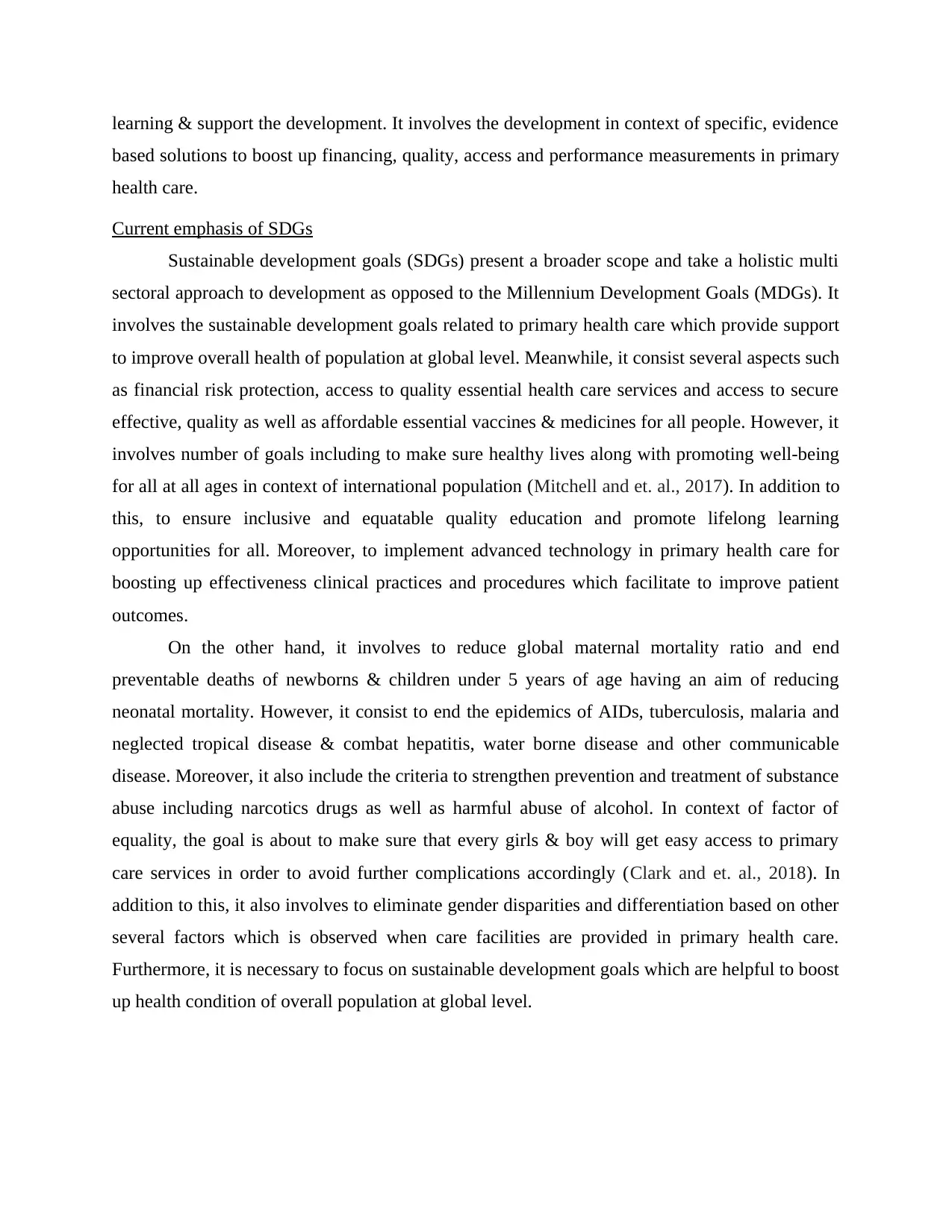
learning & support the development. It involves the development in context of specific, evidence
based solutions to boost up financing, quality, access and performance measurements in primary
health care.
Current emphasis of SDGs
Sustainable development goals (SDGs) present a broader scope and take a holistic multi
sectoral approach to development as opposed to the Millennium Development Goals (MDGs). It
involves the sustainable development goals related to primary health care which provide support
to improve overall health of population at global level. Meanwhile, it consist several aspects such
as financial risk protection, access to quality essential health care services and access to secure
effective, quality as well as affordable essential vaccines & medicines for all people. However, it
involves number of goals including to make sure healthy lives along with promoting well-being
for all at all ages in context of international population (Mitchell and et. al., 2017). In addition to
this, to ensure inclusive and equatable quality education and promote lifelong learning
opportunities for all. Moreover, to implement advanced technology in primary health care for
boosting up effectiveness clinical practices and procedures which facilitate to improve patient
outcomes.
On the other hand, it involves to reduce global maternal mortality ratio and end
preventable deaths of newborns & children under 5 years of age having an aim of reducing
neonatal mortality. However, it consist to end the epidemics of AIDs, tuberculosis, malaria and
neglected tropical disease & combat hepatitis, water borne disease and other communicable
disease. Moreover, it also include the criteria to strengthen prevention and treatment of substance
abuse including narcotics drugs as well as harmful abuse of alcohol. In context of factor of
equality, the goal is about to make sure that every girls & boy will get easy access to primary
care services in order to avoid further complications accordingly (Clark and et. al., 2018). In
addition to this, it also involves to eliminate gender disparities and differentiation based on other
several factors which is observed when care facilities are provided in primary health care.
Furthermore, it is necessary to focus on sustainable development goals which are helpful to boost
up health condition of overall population at global level.
based solutions to boost up financing, quality, access and performance measurements in primary
health care.
Current emphasis of SDGs
Sustainable development goals (SDGs) present a broader scope and take a holistic multi
sectoral approach to development as opposed to the Millennium Development Goals (MDGs). It
involves the sustainable development goals related to primary health care which provide support
to improve overall health of population at global level. Meanwhile, it consist several aspects such
as financial risk protection, access to quality essential health care services and access to secure
effective, quality as well as affordable essential vaccines & medicines for all people. However, it
involves number of goals including to make sure healthy lives along with promoting well-being
for all at all ages in context of international population (Mitchell and et. al., 2017). In addition to
this, to ensure inclusive and equatable quality education and promote lifelong learning
opportunities for all. Moreover, to implement advanced technology in primary health care for
boosting up effectiveness clinical practices and procedures which facilitate to improve patient
outcomes.
On the other hand, it involves to reduce global maternal mortality ratio and end
preventable deaths of newborns & children under 5 years of age having an aim of reducing
neonatal mortality. However, it consist to end the epidemics of AIDs, tuberculosis, malaria and
neglected tropical disease & combat hepatitis, water borne disease and other communicable
disease. Moreover, it also include the criteria to strengthen prevention and treatment of substance
abuse including narcotics drugs as well as harmful abuse of alcohol. In context of factor of
equality, the goal is about to make sure that every girls & boy will get easy access to primary
care services in order to avoid further complications accordingly (Clark and et. al., 2018). In
addition to this, it also involves to eliminate gender disparities and differentiation based on other
several factors which is observed when care facilities are provided in primary health care.
Furthermore, it is necessary to focus on sustainable development goals which are helpful to boost
up health condition of overall population at global level.
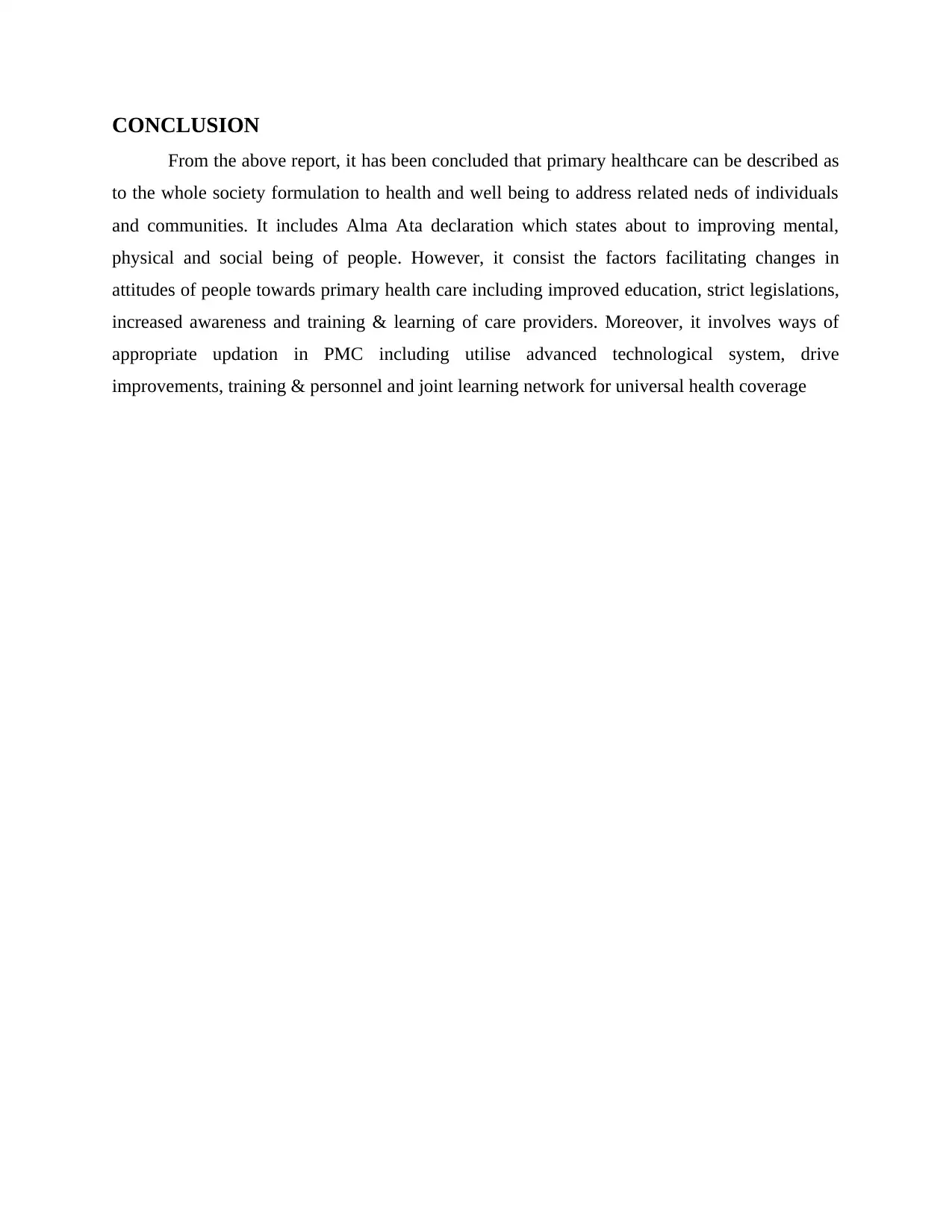
CONCLUSION
From the above report, it has been concluded that primary healthcare can be described as
to the whole society formulation to health and well being to address related neds of individuals
and communities. It includes Alma Ata declaration which states about to improving mental,
physical and social being of people. However, it consist the factors facilitating changes in
attitudes of people towards primary health care including improved education, strict legislations,
increased awareness and training & learning of care providers. Moreover, it involves ways of
appropriate updation in PMC including utilise advanced technological system, drive
improvements, training & personnel and joint learning network for universal health coverage
From the above report, it has been concluded that primary healthcare can be described as
to the whole society formulation to health and well being to address related neds of individuals
and communities. It includes Alma Ata declaration which states about to improving mental,
physical and social being of people. However, it consist the factors facilitating changes in
attitudes of people towards primary health care including improved education, strict legislations,
increased awareness and training & learning of care providers. Moreover, it involves ways of
appropriate updation in PMC including utilise advanced technological system, drive
improvements, training & personnel and joint learning network for universal health coverage
⊘ This is a preview!⊘
Do you want full access?
Subscribe today to unlock all pages.

Trusted by 1+ million students worldwide

REFERENCES
Books and journals
Baum, F., 2016. The new public health (No. Ed. 4). Oxford University Press.
Read, P. and et. al., 2017. Delivering direct acting antiviral therapy for hepatitis C to highly
marginalised and current drug injecting populations in a targeted primary health care
setting. International Journal of Drug Policy, 47, pp.209-215.
Langford, M., Higgs, G. and Fry, R., 2016. Multi-modal two-step floating catchment area
analysis of primary health care accessibility. Health & place, 38, pp.70-81.
Launer, J., 2017. Narrative-based primary care: a practical guide. CRC Press.
Willis, E., Reynolds, L. and Keleher, H. eds., 2016. Understanding the Australian health care
system. Elsevier Health Sciences.
Cummings, N. A., 2016. Behavioral health in primary care: Dollars and sense. In Psyche’s
Prophet (pp. 141-155). Routledge.
Maruish, M.E. ed., 2017. Handbook of psychological assessment in primary care settings. Taylor
& Francis.
Thomas, P., 2017. Integrating Primary Healthcare: leading, managing, facilitating. CRC Press.
Hassona, Y. and et. al., 2016. Factors influencing early detection of oral cancer by primary
health-care professionals. Journal of Cancer Education, 31(2), pp.285-291.
Mitchell, L. J. and et. al., 2017. Effectiveness of dietetic consultations in primary health care: a
systematic review of randomized controlled trials. Journal of the Academy of Nutrition
and Dietetics, 117(12), pp.1941-1962.
Clark, B. A. and et. al., 2018. Non-binary youth: Access to gender-affirming primary health
care. International Journal of Transgenderism, 19(2), pp.158-169.
Online
Putting People First: A Primary Health Care Success in Rural. 2010. [Online]. Available
Through: <https://www.ncbi.nlm.nih.gov/pmc/articles/PMC2940196/>
Books and journals
Baum, F., 2016. The new public health (No. Ed. 4). Oxford University Press.
Read, P. and et. al., 2017. Delivering direct acting antiviral therapy for hepatitis C to highly
marginalised and current drug injecting populations in a targeted primary health care
setting. International Journal of Drug Policy, 47, pp.209-215.
Langford, M., Higgs, G. and Fry, R., 2016. Multi-modal two-step floating catchment area
analysis of primary health care accessibility. Health & place, 38, pp.70-81.
Launer, J., 2017. Narrative-based primary care: a practical guide. CRC Press.
Willis, E., Reynolds, L. and Keleher, H. eds., 2016. Understanding the Australian health care
system. Elsevier Health Sciences.
Cummings, N. A., 2016. Behavioral health in primary care: Dollars and sense. In Psyche’s
Prophet (pp. 141-155). Routledge.
Maruish, M.E. ed., 2017. Handbook of psychological assessment in primary care settings. Taylor
& Francis.
Thomas, P., 2017. Integrating Primary Healthcare: leading, managing, facilitating. CRC Press.
Hassona, Y. and et. al., 2016. Factors influencing early detection of oral cancer by primary
health-care professionals. Journal of Cancer Education, 31(2), pp.285-291.
Mitchell, L. J. and et. al., 2017. Effectiveness of dietetic consultations in primary health care: a
systematic review of randomized controlled trials. Journal of the Academy of Nutrition
and Dietetics, 117(12), pp.1941-1962.
Clark, B. A. and et. al., 2018. Non-binary youth: Access to gender-affirming primary health
care. International Journal of Transgenderism, 19(2), pp.158-169.
Online
Putting People First: A Primary Health Care Success in Rural. 2010. [Online]. Available
Through: <https://www.ncbi.nlm.nih.gov/pmc/articles/PMC2940196/>
1 out of 10
Related Documents
Your All-in-One AI-Powered Toolkit for Academic Success.
+13062052269
info@desklib.com
Available 24*7 on WhatsApp / Email
![[object Object]](/_next/static/media/star-bottom.7253800d.svg)
Unlock your academic potential
Copyright © 2020–2025 A2Z Services. All Rights Reserved. Developed and managed by ZUCOL.





